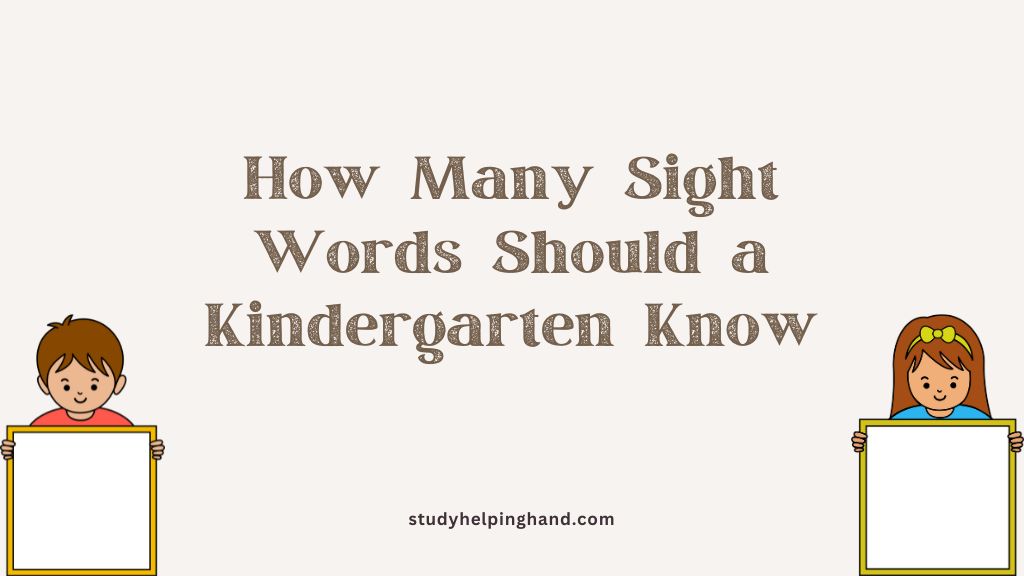Sight words are generally used words that young children need to memorize for efficient reading. These words are seen and used frequently in reading materials and are usually not spelled phonetically, making it difficult for new readers to sound them out. Kindergarten is a crucial stage in a child’s reading journey, as it lays the foundation for reading and comprehension. Hence, it’s essential to determine how many sight words a kindergarten should know to build a strong foundation for lifelong reading.
Why Sight Words are Important in Kindergarten
Sight words are a critically essential part of any kindergartener’s reading journey. In their early stages of reading, children need to comprehend most words in the text fluently to ensure that they can read and understand the context to make sense of what they’re reading. Phonics, which involves reading words in terms of their individual sounds or syllables, is the primary reading method used in schools. However, phonics cannot be used to read all words, especially sight words like “the,” “and,” “is,” etc.
Sight words pose a unique challenge for kindergarten children as they need to commit these words to memory since it is not enough to sound them out. Therefore, kindergarten educators emphasise sight word memorization as part of their teaching strategy because it helps set a solid foundation for full literacy.
How Many Sight Words Should a Kindergarten Know?
The number of sight words a kindergartner should know varies depending on several factors such as the curriculum, literacy targets, and the individual needs of the child. However, a general rule of thumb is that a kindergarten child should aim to memorize between 25-50 sight words over the course of the term or semester. In some cases, the numbers could be higher or lower depending on the educational institution and the reading level of the child.
It’s worth mentioning that how quickly a child can learn sight words is as important as how many sight words they know. While it’s crucial for a kindergarten child to know sight words, it’s also equally important to ensure they are learning at a pace that suits them. The emphasis of kindergarten reading and literacy targets should be on acquiring the tools and skills that will enable children to excel in reading and other subjects down the line.
| Also read: College Survival Tips For Students |
How to Teach Sight Words to Kindergarten Children
Teaching sight words can be challenging, and it’s important to make the process fun and engaging for the child. Below are some recommendations to help educators and parents teach sight words effectively.
- Make it fun: Children are more receptive to learning when they’re having fun. To teach sight words, think outside the box and incorporate different tools such as puzzles, flashcards, word games, and toys to engage the child and make it enjoyable.
- Use repetition: Repetition is essential in teaching sight words. A child needs to see and say the sight word multiple times to commit it to long-term memory effectively.
- Start small: Begin with a manageable number of sight words that the child can focus on memorizing without feeling overwhelmed. Starting small helps build a child’s confidence and makes the learning process less daunting.
- Use props to make learning tactile: Children are tactile learners, and using different props such as sandpaper letters or clay to spell out sight words can make the process more interactive and enjoyable for them.
- Use technology: Technology can be an excellent tool to reinforce sight word learning. Educational apps and online videos can supplement classroom instruction and provide a fun and engaging way for children to interact with sight words.
| Also read: 30 Best Read Alouds for Kindergarten |
Conclusion
The importance of knowing sight words in kindergarten cannot be overemphasised. A child who can recognize and read sight words at the appropriate level is well on their way to becoming an excellent reader. However, teachers and parents must not forget that how quickly a child can learn sight words is as important as how many sight words they know. Creating a fun and engaging learning environment, setting achievable targets, and incorporating multiple learning techniques can help children learn sight words at a pace that suits them, and ultimately set them up for success.



